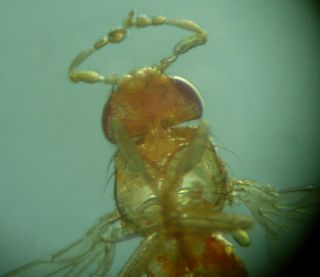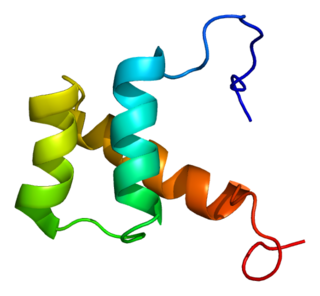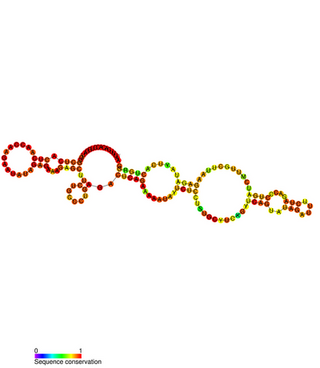Related Research Articles

Evolutionary developmental biology is a field of biological research that compares the developmental processes of different organisms to infer how developmental processes evolved.

A homeobox is a DNA sequence, around 180 base pairs long, that regulates large-scale anatomical features in the early stages of embryonic development. Mutations in a homeobox may change large-scale anatomical features of the full-grown organism.
The ParaHox gene cluster is an array of homeobox genes from the Gsx, Xlox (Pdx) and Cdx gene families.
Hox genes, a subset of homeobox genes, are a group of related genes that specify regions of the body plan of an embryo along the head-tail axis of animals. Hox proteins encode and specify the characteristics of 'position', ensuring that the correct structures form in the correct places of the body. For example, Hox genes in insects specify which appendages form on a segment, and Hox genes in vertebrates specify the types and shape of vertebrae that will form. In segmented animals, Hox proteins thus confer segmental or positional identity, but do not form the actual segments themselves.

Antennapedia is a Hox gene first discovered in Drosophila which controls the formation of legs during development. Loss-of-function mutations in the regulatory region of this gene result in the development of the second leg pair into ectopic antennae. By contrast gain-of-function alleles convert antennae into ectopic legs.

Otic vesicle, or auditory vesicle, consists of either of the two sac-like invaginations formed and subsequently closed off during embryonic development. It is part of the neural ectoderm, which will develop into the membranous labyrinth of the inner ear. This labyrinth is a continuous epithelium, giving rise to the vestibular system and auditory components of the inner ear. During the earlier stages of embryogenesis, the otic placode invaginates to produce the otic cup. Thereafter, the otic cup closes off, creating the otic vesicle. Once formed, the otic vesicle will reside next to the neural tube medially, and on the lateral side will be paraxial mesoderm. Neural crest cells will migrate rostral and caudal to the placode.

Homeobox protein MSX-2 is a protein that in humans is encoded by the MSX2 gene.

Homeobox protein Hox-B5 is a protein that in humans is encoded by the HOXB5 gene.

Homeobox protein Hox-C8 is a protein that in humans is encoded by the HOXC8 gene.

Homeobox protein Hox-D13 is a protein that in humans is encoded by the HOXD13 gene. This gene belongs to the homeobox family of genes. The homeobox genes encode a highly conserved family of transcription factors that play an important role in morphogenesis in all multicellular organisms.

Homeobox protein DLX-5 is a protein that in humans is encoded by the distal-less homeobox 5 gene, or DLX5 gene. DLX5 is a member of DLX gene family.

Homeobox protein DLX-3 is a protein that in humans is encoded by the DLX3 gene.

Homeobox protein DLX-4 is a protein that in humans is encoded by the DLX4 gene.

Homeobox protein Hox-C5 is a protein that in humans is encoded by the HOXC5 gene.

Homeobox protein DLX-2 is a protein that in humans is encoded by the DLX2 gene.

Homeobox protein Hox-C11 is a protein that in humans is encoded by the HOXC11 gene.

Homeobox protein DLX-1 is a protein that in humans is encoded by the DLX1 gene.

Homeobox protein DLX-6 is a protein that in humans is encoded by the DLX6 gene.

Homeobox protein DBX2, also known as developing brain homeobox protein 2, is a protein that in humans is encoded by the DBX2 gene. DBX2 plays an important role in the development of the central nervous system, specifically in the development of the neural tube and brain. DBX2 is located on chromosome 12 and is approximately 36,000 base pairs long. DBX2 is predicted to enable DNA-binding transcription activity as well as being involved in the regulation of transcription by RNA polymerase II.

DLX6 antisense RNA 1 (DLX6-AS1) is a developmentally-regulated long non-coding RNA. In rats, it is expressed in neurons in the subventricular zone of the developing forebrain. Its expression is linked to that of the Shh and DLX families of genes, which are important in ventral forebrain and craniofacial development. An alternatively spliced form of DLX6-AS1, DLX6-AS2, forms a stable complex with the Dlx-2 protein. This complex activates transcription of Dlx-5 and Dlx-6.
References
- ↑ Panganiban G, Rubenstein JL (October 2002). "Developmental functions of the Distal-less/Dlx homeobox genes". Development. 129 (19): 4371–86. doi:10.1242/dev.129.19.4371. PMID 12223397.
- ↑ Stock DW, Ellies DL, Zhao Z, Ekker M, Ruddle FH, Weiss KM (October 1996). "The evolution of the vertebrate Dlx gene family". Proceedings of the National Academy of Sciences of the United States of America. 93 (20): 10858–63. Bibcode:1996PNAS...9310858S. doi: 10.1073/pnas.93.20.10858 . PMC 38247 . PMID 8855272.
- 1 2 Panganiban G, Irvine SM, Lowe C, Roehl H, Corley LS, Sherbon B, et al. (May 1997). "The origin and evolution of animal appendages". Proceedings of the National Academy of Sciences of the United States of America. 94 (10): 5162–6. Bibcode:1997PNAS...94.5162P. doi: 10.1073/pnas.94.10.5162 . PMC 24649 . PMID 9144208.
- ↑ Stock DW, Ellies DL, Zhao Z, Ekker M, Ruddle FH, Weiss KM (October 1996). "The evolution of the vertebrate Dlx gene family". Proceedings of the National Academy of Sciences of the United States of America. 93 (20): 10858–63. Bibcode:1996PNAS...9310858S. doi: 10.1073/pnas.93.20.10858 . PMC 38247 . PMID 8855272.
- ↑ "dlx AND(Danio rerio[organism])". NCBI Gene. Retrieved 12 March 2018.
- ↑ "Entrez Gene: DLX4 distal-less homeobox 4".
- ↑ Nakamura S, Stock DW, Wydner KL, Bollekens JA, Takeshita K, Nagai BM, et al. (December 1996). "Genomic analysis of a new mammalian distal-less gene: Dlx7". Genomics. 38 (3): 314–24. doi: 10.1006/geno.1996.0634 . PMID 8975708.
- ↑ Quinn LM, Johnson BV, Nicholl J, Sutherland GR, Kalionis B (March 1997). "Isolation and identification of homeobox genes from the human placenta including a novel member of the Distal-less family, DLX4". Gene. 187 (1): 55–61. doi:10.1016/S0378-1119(96)00706-8. PMID 9073066.
We originally submitted the cDNA sequence to the Genbank database as DLX8 (Accession number U31762) even though human DLX4 or DLX7 had not been identified. [...] This new Distal-less gene could not be considered the human homologue of murine Dlx4 or Dlx7 because the homeodomain sequences were too diverged.
- ↑ Vieux-Rochas M, Coen L, Sato T, Kurihara Y, Gitton Y, Barbieri O, et al. (June 2007). Heisenberg C (ed.). "Molecular dynamics of retinoic acid-induced craniofacial malformations: implications for the origin of gnathostome jaws". PLOS ONE. 2 (6): e510. Bibcode:2007PLoSO...2..510V. doi: 10.1371/journal.pone.0000510 . PMC 1876820 . PMID 17551590.

- ↑ Vieux-Rochas M, Bouhali K, Baudry S, Fontaine A, Coen L, Levi G (December 2010). "Irreversible effects of retinoic acid pulse on Xenopus jaw morphogenesis: new insight into cranial neural crest specification". Birth Defects Research Part B: Developmental and Reproductive Toxicology. 89 (6): 493–503. doi:10.1002/bdrb.20269. PMID 21086490.
- ↑ Anderson SA, Eisenstat DD, Shi L, Rubenstein JL (October 1997). "Interneuron migration from basal forebrain to neocortex: dependence on Dlx genes". Science. 278 (5337): 474–6. doi:10.1126/science.278.5337.474. PMID 9334308.
- ↑ Cobos I, Borello U, Rubenstein JL (June 2007). "Dlx transcription factors promote migration through repression of axon and dendrite growth". Neuron. 54 (6): 873–88. doi:10.1016/j.neuron.2007.05.024. PMC 4921237 . PMID 17582329.
- ↑ Cobos I, Calcagnotto ME, Vilaythong AJ, Thwin MT, Noebels JL, Baraban SC, Rubenstein JL (August 2005). "Mice lacking Dlx1 show subtype-specific loss of interneurons, reduced inhibition and epilepsy". Nature Neuroscience. 8 (8): 1059–68. doi:10.1038/nn1499. PMID 16007083. S2CID 883159.
- ↑ Shimamoto T, Nakamura S, Bollekens J, Ruddle FH, Takeshita K (April 1997). "Inhibition of DLX-7 homeobox gene causes decreased expression of GATA-1 and c-myc genes and apoptosis". Proceedings of the National Academy of Sciences of the United States of America. 94 (7): 3245–9. Bibcode:1997PNAS...94.3245S. doi: 10.1073/pnas.94.7.3245 . PMC 20354 . PMID 9096378.
- ↑ Beverdam A, Merlo GR, Paleari L, Mantero S, Genova F, Barbieri O, et al. (December 2002). "Jaw transformation with gain of symmetry after Dlx5/Dlx6 inactivation: mirror of the past?". Genesis. 34 (4): 221–7. doi:10.1002/gene.10156. hdl: 2318/87307 . PMID 12434331. S2CID 19592597.
- ↑ Depew MJ, Lufkin T, Rubenstein JL (October 2002). "Specification of jaw subdivisions by Dlx genes". Science. 298 (5592): 381–5. doi: 10.1126/science.1075703 . PMID 12193642. S2CID 10274300.
- ↑ Vieux-Rochas M, Mantero S, Heude E, Barbieri O, Astigiano S, Couly G, et al. (June 2010). "Spatio-temporal dynamics of gene expression of the Edn1-Dlx5/6 pathway during development of the lower jaw" (PDF). Genesis. 48 (6): 262–373. doi:10.1002/dvg.20625. hdl: 2318/79557 . PMID 20333701. S2CID 1050844.